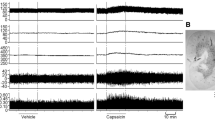Abstract
Among several mediators, nitric oxide (NO) and calcitonin gene-related peptide (CGRP) were suggested to be involved in the mechanism of preconditioning. We examined the possible role of the cardiac capsaicin-sensitive sensory innervation in pacing-induced preconditioning, as well as in the cardiac NO and CGRP content. Wistar rats were treated subcutaneously with capsaicin or its solvent in the sequence of 10, 30, and 50 mg/kg increasing single daily doses for 3 days to deplete neurotransmitters of the sensory innervation. Isolated hearts from both groups were then subjected to either preconditioning induced by three consecutive periods of pacing at 600 beats per minute for 5 min with 5 min interpacing periods, or time-matched non-preconditioning perfusion, followed by a 10-min coronary occlusion. NO content of left ventricular tissue samples was assayed by electron-spin resonance, and CGRP release was determined by radioimmunoassay. CGRP immunohistochemistry was also performed. In the non-preconditioned, solvent-treated group, coronary occlusion decreased cardiac output (CO) from 68.1 to 32.1 mL/min, increased left ventricular end-diastolic pressure (LVEDP) from 0.58 to 1.90 kPa, and resulted in 200 mU/min/g LDH release. Preconditioning significantly increased ischaemic CO to 42.9 mL/min (P < 0.05), decreased ischaemic LVEDP to 1.26 kPa (P < 0.05) and decreased LDH release to 47 mU/min/g (P < 0.05) in the solvent-treated group. Preconditioning did not confer protection in the capsaicin-pretreated group (ischaemic CO: 35.6 mL/min; LVEDP: 1.76 kPa; LDH 156 mU/min/g). Capsaicin-treatment markedly decreased cardiac NO content, CGRP release, and CGRP-immunoreactivity. Conclusions: (i) The presence of an intact local sensory innervation is a prerequisite to elicit pacing-induced preconditioning in the rat heart. (ii) A significant portion of cardiac basal NO content may be of neural origin. (iii) Release of NO and CGRP from capsaicin-sensitive nerves may be involved in the mechanism of pacing-induced preconditioning.
Similar content being viewed by others
Author information
Authors and Affiliations
Additional information
Received: 2 April 1997 / Accepted: 3 June 1997
Rights and permissions
About this article
Cite this article
Ferdinandy, P., Csont, T., Csonka, C. et al. Capsaicin-sensitive local sensory innervation is involved in pacing-induced preconditioning in rat hearts: role of nitric oxide and CGRP?. Naunyn-Schmiedeberg's Arch Pharmacol 356, 356–363 (1997). https://doi.org/10.1007/PL00005062
Issue Date:
DOI: https://doi.org/10.1007/PL00005062




